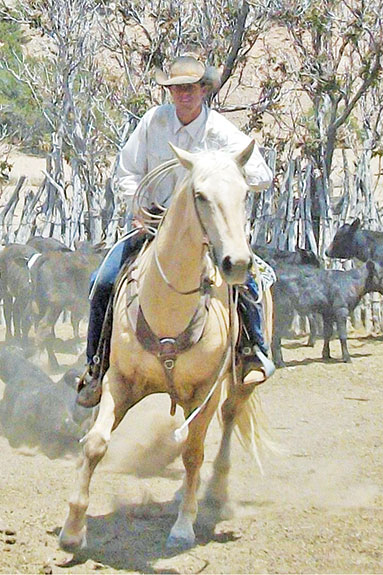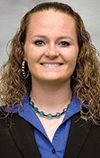However, building these ranch horses takes an experienced trainer and dedicated time.
Curt Boyd is one of these trainers. A horseman by heart, Boyd and his wife, Susan, train ranch horses on their ranch in central New Mexico.
They are currently running around 180 pairs and use their horses, as well as Australian Shepherds, to work their cattle.
The Boyds have trained horses for years and used to train and show for outside clients. “When we moved here, my wife was training and taking outside clients. We have always had horses and were training outside horses,” he says.
He continues, “It got to the point where she was leaving to go to shows, and I’d show some with her in the cow horse. Then I would go shoe horses. We had outside help that would come take care of the ranch and we would pay them.
We decided then we weren’t going to show anymore, and the training and the horse industry slowed down. We decided that instead of putting the energy into someone else’s horses, we would just do it here.”

That is when they decided to begin their training of ranch horses and to sell a finished horse instead of training for others.
They usually have between eight and 20 horses in training, depending on the time of the year.
They do not breed and raise the horses but instead look for horses that have potential.
“We buy some horses that are trained and some that are not. We find many of them on reputable ranches.
Due to our showing background, we may work on some stuff in the arena where they are more rounded horses such as ranch versatility, cow work or roping,” Boyd says.
He adds, “We want them riding a little better show-wise as well.
We may take a cow horse, such as a cutter or working cow horse, and make it more of a ranch horse. We work on fine-tuning them.”
They sell around 25 horses a year and are always looking for that next horse to train.
“I don’t buy anything that we wouldn’t use here on the ranch, and I don’t buy anything that would be a barrel horse or a jumper,” Boyd states. “We don’t trailer anywhere, so these horses need to be able to work.”
It takes time to find these horses, and Boyd has a special type of horse he is looking for.
“A big part of what we try to do is evaluate horses, so they will stay gentle and sound and won’t buck someone off. We make sure they are something we want to represent and sell,” he explains.
The horses he buys range from green to seasoned. “I will buy some green horses and ones that haven’t had a lot of experience. I may keep them for six months to a year.
I also buy some trained horses that just need some fine-tuning and that may be one that only needs a few weeks,” Boyd states.
He adds, “We tend to be busy in the spring and the fall for the big work. We go to brandings and drag calves, and sometimes that may be a good opportunity to sell one. In the fall when the cows are gathered, sorted and sold, you can sell one then, too.”
The focus of his training is on getting the horses experience, using them frequently and putting miles on them. “We have a lot of rock and a lot of brush, and we drag calves at branding and sort everything horseback in the pens or in the pasture.
If we have something that you have to doctor outside, our pens are usually too far away, so we doctor from the horse. We use the horses for everything, so they get a lot of experience on our ranch,” he explains.
Each horse reacts differently and is good at different things. “Some of the horses are really good at things, and some are really green. Some will cut a cow a lot better, and some will rope better.
It just depends on the horses. I have a variety of sizes. I like a little cow horse, but you can’t market that as one that will tie down and drag one in a trailer,” Boyd explains.
However, there are several aspects each horse must be good at. “The main thing most people are looking for is one that will stay gentle and one that has seen a lot. That is a horse we can provide,” he says.
It’s a challenge to find the right horses. “A lot of people want one who is pretty, has some color and can do everything. That’s pretty hard to find,” he states. “However, we do find those that are pretty with color and still have some ability.”
One of the biggest advantages he sees to training horses he owns is in the liability and the stress. “There can be a lot of stress in trying to pamper and take care of someone else’s horses. You still take care of your own, but you aren’t worrying about someone else’s property,” he says.
He adds, “It gets you working for our own horse instead of someone else’s.”
The Boyds also supplement their ranch income by breeding and raising Australian Shepherd cow dogs. “A big part of the cow dog thing came out of necessity.
We have always had dogs and always used them, but when we bought this space and stocked it, we had some tough cattle that were spoiled. It became more and more apparent that we needed more help,” he says.
He continues, “So we started raising dogs and kept improving the dogs that we had, and their bloodlines, and figured out what we liked.”
The diversification on the ranch has allowed the Boyds to continue to do what they love, ranching, while maintaining a profitable enterprise. “Having this other income has helped tremendously to keep us in business and profitable.
We used to train outside horses for a fee and that provided some income for what the cow deal couldn’t,” Boyd states.
He adds, “We look at the ranch horse selling the same way, and it helps us keep our ranch.” ![]()
For more information go to this website.
Robyn Scherer is a freelance writer based in Colorado.
PHOTOS
TOP: While Boyd's horses have varied skills, the common target is to have a calm demeanor.
BOTTOM: To train horses, Boyd makes sure they gain experience and get plenty of miles. Photos courtesy of Curt and Susan Boyd.








